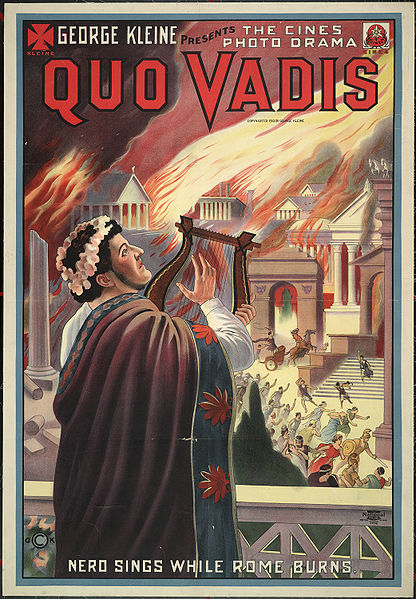This week marks the anniversary of the Great Fire of Rome, one of the worst disasters ever to hit the Eternal City. This tragic event took place during the reign of Nero in 64 AD. The fire began in the merchant area near the Circus Maximus and rapidly spread through the dry, wooden structures of the capital. According to Tacitus, the fire burned for six days and seven nights. Only four of the fourteen districts of Rome escaped the fire; three were completely destroyed, and the other seven suffered severe damage.
—

—
Despite his efforts to quell the blaze and rebuild the city, rumours accusing Nero soon arose. It was believed that the Emperor had ordered the torching of the city so that he could rebuild Rome to his liking. The ancient sources carry conflicting accounts of whether the fire was started deliberately or was an accident. Suetonius and Cassius Dio point the finger at Nero as the culprit, burning the city in order to construct a new Imperial palace, whilst Tacitus says that an obscure new religious sect called the Christians confessed to causing the blaze. To make matters worse, Cassius Dio tells us that Nero sang the “Sack of Ilium” in stage costume as the city burned. Nero himself blamed the fire on the Christians and, according to Tacitus (Annals XV.44), ordered them to be thrown to dogs while others were crucified or burned to serve as lights.
—-

—
For the general public of the 20th century, the Polish writer Henryk Sienkiewicz (Nobel prize in literature in 1905), rather than Roman historians, had the biggest influence in shaping Nero’s terrible reputation. His book « Quo Vadis », relating Nero’s reign and the fire of Rome, was published in 1896 and soon gained international renown (the writer used the figure of Nero to condemn the actions of the Russian Tsar Alexander II towards Poland and the Polish Catholic Church some 20 years before the publication of his book). Excited by new archaeological discoveries made in Rome since 1870, Sienkiewicz tells the story of early Christianity in Rome, with protagonists struggling against Emperor Nero’s regime.
While using the writings of Tacitus, Suetonius and Dion Cassius as a source for his story, Sienkiewicz tends to exaggerate every aspect of Nero’s personality and actions. He appears as a cruel, infantile, crazy and perverted individual. The book also designates Nero as the sole culprit for the burning of Rome. This fictional Nero became an endless source of inspiration for the cinematographers who brought the infamous Emperor to the screen.

—
The novel was adapted several times in more or less faithful versions. The most famous version featuring Peter Ustinov was released to public acclaim in 1951. Several other movies, though not direct adaptations of “Quo Vadis”, also relied heavily on Sienkiewicz’s writings to represent Nero.
The burning of Rome as seen in 1951’s Quo Vadis:
Selected works:
Quo Vadis (Enrico Guazzoni, 1913)
Quo Vadis (Gabriellino d’Annunzio, 1924)

Quo Vadis (Mervyn Leroy, 1951)
Quo Vadis (Franco Rossi, 1985) (TV)
Quo Vadis (Jerzy Kawalerowicz, 2001)
—
Other interesting movies about Nero & the Fire of Rome:
Nero, or the Fall of Rome (Luigi Maggi and Arturo Ambrosio, 1909)
The Sign of the Cross (Cecil B. DeMille, 1932)
Nerone e Messalina (Primo Zeglio , 1953)
Mio figlio Nerone (Stefano Vanzina, 1956)


Good survey of Nero and the Hollywood Romans.
Thanks.
What a useful work! Can I have your permission to translate it into my mother language, a non-profit Vietnamese translation on my wordpress? I will write author’s name fully and source link to this blog. Thank you.
Yes, sure!